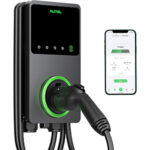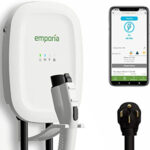State of Charge
Charging Station Reviews
We independently review every item we recommend. If you buy through our links, we may earn a small commission that helps us continue to make quality content for you. Thanks for your support!
J+ Booster 2 EV Charging Station Review
A tough, powerful portable EV charging station
Table of Contents:
Range anxiety is one of the issues that make consumers most hesitant to switch from gasoline to electric vehicles, which is totally understandable. It’s generally not hard to find a gas station when your tank is getting low, but large parts of the country still lacks the charging infrastructure needed to top up your EV. That leaves some folks nervous about making long-distance trips and inadvertently finding themselves stuck on the side of the highway with a dead battery.
But a few manufacturers are hopping in to try and quell some of those apprehensions by way of portable charging systems– an EVSE that can be plugged in practically anywhere to bring your EV back to life.
A recent Swiss import aims to fill that void with quality and style in the US with the J+ Booster 2. The highly popular charger goes by the name of ‘Juice Booster 2’ in Europe, but Juice Technology changed the name so it wouldn’t get confused with the Enel X JuiceBox EV charger. While it might be lightweight at only 2.2 pounds (or about 1 kilogram, not counting the cable), this charging station pulls no punches with its rugged military-grade casing and robust power output, so I was pretty eager to test it out for myself.
Key Specs of the J+ Booster 2
The beauty of having a portable EV charger is that there really isn’t anything to install unless you plan on mounting it in a permanent location. Juice Americas does provide a steel wall bracket so that you can install it on the wall and for daily use– just mount the bracket on the wall near your NEMA 14-50 or NEMA 5-15 outlet (your standard 120-volt household outlet in the US and Canada) and snap the unit into place. The dual voltage adaptors are really robust, and the unit comes with a thick rubberized cap to protect the socket. It is worth mentioning that the plug is situated on top of the unit instead of the bottom, where it is with most chargers, and the power cable is very short– there are only about two feet from the end of the plug to the opposite end of the charging unit, so mounting could get a little awkward.
Do you need another type of plug instead? Juice Americas does offer the NEMA 6-15, 5-20, 6-20, TT-30, 14-30, and 6-50 plugs as optional extras, which is a wide selection we don’t often see. The company also offers a combination lock that can be connected to a couple of holes in the side of the mounting bracket to provide an extra level of security for your unit in case you mount it outside or in a common garage.
The J+ Booster 2 delivers up to 9.6 kW to your EV when using the NEMA 14-50 adaptor and up to 1.4 kW using the NEMA 5-15 plug. Thanks to 21’ and 25’ cable options, you’ve got plenty of room to work with when you need to charge your vehicle. It’s also UL safety certified and comes with an IP67 rating (equivalent to a NEMA 6), meaning that it’s dustproof and waterproof and can be submerged in up to 39” of water for up to 30 minutes.
It is worth mentioning that while I did test the J+ Booster 2 for a couple of weeks, I actually had to contact Juice Americas for a replacement early on since the first unit I tested faulted after only two days of use. I’m not going to kill the review for this, because electrical equipment sometimes fails, but I will note it in my final rating.
I was far from impressed with the connector holster, however. After hanging it up in the provided slot, there’s literally nowhere to hang the cable; you can’t hang it over the top of the unit, and you can’t hang it over the connector holster. Just leaving the cable lying on the floor makes it a tripping hazard and runs the risk of damaging it if it’s stepped on or run over by a vehicle. The holster also holds the connector with the pins up, so dust, moisture, and anything else in the air can settle inside if you don’t cover it with the plastic cap when you’re done using it. It’s just not convenient. If you’re planning on using the J+ Booster 2 every day, you may want to seriously consider buying a third-party cable management system like this remote holster and cable hook combo.
Testing
None of us want to spend a bunch of money on an EVSE only to discover that it’s poor quality or doesn’t function well in extreme weather conditions. That’s why I test all of the EV charging stations I can by mimicking a lot of real-world circumstances that consumers could potentially encounter. You deserve to learn as much as possible about the product you’re about to invest in, preferably from an unbiased source!
The Connector Drop Test
Accidents happen, and everyone is bound to drop a connector once in a while charging their EV. And considering how expensive it can be to repair a broken connector or even be forced to replace a busted charging station, you want to ensure that your equipment can withstand a little rough treatment. I test connectors by dropping them to the concrete floor of my garage about five times in a row from about chest height. The J+ Booster 2 fared well, probably in part due to the thick rubber cap at the end of the connector that helped absorb the blow.
The Cable Deep Freeze Test
Next up comes a test to determine how the cable would hold up in the extreme cold, which involves a 24-hour stay in a commercial ice cream freezer. I measured the interior temperature at -10.5° F (-23.6° C) when I opened it up, and the cable unwound okay after I remounted the J+ Booster 2, but it didn’t handle as well as I thought it would compared to the OpenEVSE or the Tesla Wall Connector, which have similarly thin cables. It’s not bad; since it’s so thin, you can just overpower it, but it did try to remain in the smaller loops I initially froze it in. But I would have liked to see it do better.
The Submersion Test
Thanks to its IP67 rating, which is equivalent to a NEMA 6 rating, the J+ Booster 2 is capable of being submerged in up to 39 inches of water for up to 30 minutes. In order to test this, I completely submerged the unit in a bucket of water and plugged it into my truck to charge, and the charger handled it like a champ. Because I’m fond of pushing limits here at State of Charge, I even left it in the bucket for over two hours and came back to find the unit still charging with no issues. That is a big pass for the submersion test.
The Crush Test
Juice Americas boasts that the J+ Booster 2 is “crush-proof” at up to 6,600 pounds, even going so far as to make a video showing the unit being run over by a tank, but doing the test in dirt seemed a bit like cheating to me. I decided to follow up their test with one of my own, but instead of a tank, I used my 6,600-pound Ford F-150 Lightning on an asphalt driveway. Then, for good measure, I rolled my Rivian R1T (which weighs about 7,200 pounds) over it too. The unit came away pretty scratched up, and the rubber caps popped off, but after putting them back in place and plugging it in, the unit went right back to charging my EV without any problems.
The J+ Booster 2 is a really solid portable charging system that works well for charging both at home and on the go. I love that it’s dual voltage, and I love that it should be able to handle all sorts of inclement weather without any issues. I could see a unit like this holding up well long-term, even with a bit of punishment. It is pretty expensive for a portable charger, but if you’re willing to pay for extra quality, this could be a good investment.
The J+ Booster 2 is available for $599 on Amazon for the 21-foot version and for $679 on Amazon for the 25-foot version. Be sure to watch my full review in the video above, and let me know your thoughts on this portable charger in the comments below.

By: Tom Moloughney
YOU MIGHT ALSO BE INTERESTED IN:


EVChargingStation’s Comment Policy
We welcome polite, respectful comments, but rudeness and personal attacks will not be tolerated. All comments are reviewed prior to publication. Thanks for joining in the conversation!









Hi Tom,
Thanks for the great reviews! I’m trying to find a portable EVSE that also meets all my home-EVSE requirements. This J+ Booster unit is SO CLOSE! The big miss is WiFi (or even Bluetooth) connectivity — mainly so that I can schedule charging around my peak rate hours. Are you aware of any portable EVSE with this feature?
A suggestion for your YouTube channel: At the end, mention some similar alternatives, such as the AmazingE, in this case. This can increase your views, too!
Thanks again,
Barry
Phoenix
Thanks for your reviews Tom! You actually steered me away from a low quality charger that I purchased on Amazon and towards this one (thankfully you commented on a post I made on the f150lightning forum). This was the perfect portable charger for what I needed (variable amps, lots of connection options) and the fact that it was the highest rated portable charger you have reviewed gave me the peace of mind in selecting it!
I’m thinking of where I would find14/50 plugs and most likely it would be behind appliances. I’d want 4’ of cable before I get to the unit. Another miss is the inability to remove and replace the charging cable like the AC cable. I would have already ordered it if these features were already in place. Looking forward to the Chargerator Score developed since this review like the Webasto Go received.